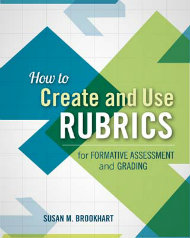The Best Ways to Use Rubrics
How to Create and Use Rubrics for Formative Assessment and Grading
By Susan M. Brookhart
(ASCD, 2013 – Learn more)
Shortly into How to Create and Use Rubrics for Formative Assessment and Grading, I realized that my rubrics were not designed to help students learn. Most of my rubrics served more as a checklist than a true rubric or learning tool.

Part 1 of How to Create and Use Rubrics actually encompasses about 75% of the pages. This section discusses what a rubric is, how to write rubrics (both as teachers and students) and provides several examples.
Target rubrics on specific learning objectives
The meat of Brookhart’s philosophy on rubrics—that rubrics should help students learn—is found in Part 1. She emphasizes that rubrics must have clear descriptions of the criteria students will demonstrate. The criteria should focus on the learning target. This was one trap I found myself guilty of—including work habits or creativity in the rubric when really the purpose of the assignment was to demonstrate an understanding of a concept, like density.
Brookhart does not advise against evaluating work habits or creativity. In fact she provides great examples of rubrics for each. She argues, effectively, that if you want a student to really learn, you have to define specific concepts or skills, not mash them all together in a single rubric.
The author divides rubrics into three different categories: general, task-specific, and proficiency-specific rubrics. General rubrics are designed for fundamental skills that develop over time. Task-specific rubrics should be used to “assess recall and comprehension of a body of knowledge.” Proficiency-based rubrics are designed for standards-based learning. She provides examples and clear explanations for all three.
The appendix includes extensive (20 pages) 6+1 trait writing rubrics for grades K-12. With the push for literacy across all subjects these rubrics would be useful for any classroom teacher. The book also includes a reference list and an index.
The appendix includes extensive (20 pages) 6+1 trait writing rubrics for grades K-12. With the push for literacy across all subjects these rubrics would be useful for any classroom teacher.
Using rubrics effectively
Part II of the book deals with using rubrics. Brookhart spends most of this time discussing two uses of rubrics—sharing learning targets and formative assessment. These uses follow her philosophy that the primary purpose of a rubric is a learning tool. Although she argues that rubrics have limited value for grading and summative assessment, Brookhart does provide several ideas for doing that fairly and effectively.
One idea in How to Create and Use Rubrics that I really liked involved providing students with a rubric as well as several work samples for the assignment. Have students evaluate the sample work using the rubric. The ensuing conversations can help students know and understand how they will be evaluated and understand the expectations of the assignment. I believe that once students go through this process they can readily self-evaluate and peer evaluate each other on subsequent assignments.
How to Create and Use Rubrics has changed the way I think about rubrics. I will reevaluate and rework many of my rubric products. I hope, as Brookhart professes, that by following her strategies my students will improve and learn better than before.
Also see MiddleWeb’s All About Rubrics resource collection.
Tracey Muise, currently at St. George’s Episcopal School in Milner, GA, has been engaging and challenging middle school students for over fifteen years in a science classroom. Previously she taught at the Episcopal School of Knoxville (TN), Girls Preparatory School (Chattanooga, TN) and the Edmund Burke School (Washington, DC). She earned her M.S. in environmental education in 1996 from Antioch New England Graduate School and her undergraduate degree in biology in 1990 from Drew University.



































